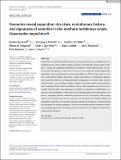Files in this item
Genomics reveal population structure, evolutionary history, and signatures of selection in the northern bottlenose whale, Hyperoodon ampullatus
Item metadata
| dc.contributor.author | de Greef, Evelien | |
| dc.contributor.author | Einfeldt, Anthony L. | |
| dc.contributor.author | Miller, Patrick James | |
| dc.contributor.author | Ferguson, Steven H. | |
| dc.contributor.author | Garroway, Colin J. | |
| dc.contributor.author | Lefort, Kyle J. | |
| dc.contributor.author | Paterson, Ian G. | |
| dc.contributor.author | Bentzen, Paul | |
| dc.contributor.author | Feyrer, Laura J. | |
| dc.date.accessioned | 2022-08-23T14:30:02Z | |
| dc.date.available | 2022-08-23T14:30:02Z | |
| dc.date.issued | 2022-08-23 | |
| dc.identifier | 280447561 | |
| dc.identifier | 05b1f618-faaa-430c-b14a-faab14d5832a | |
| dc.identifier | 85136453754 | |
| dc.identifier | 000842947500001 | |
| dc.identifier.citation | de Greef , E , Einfeldt , A L , Miller , P J , Ferguson , S H , Garroway , C J , Lefort , K J , Paterson , I G , Bentzen , P & Feyrer , L J 2022 , ' Genomics reveal population structure, evolutionary history, and signatures of selection in the northern bottlenose whale, Hyperoodon ampullatus ' , Molecular Ecology , vol. Early View . https://doi.org/10.1111/mec.16643 | en |
| dc.identifier.issn | 0962-1083 | |
| dc.identifier.other | Jisc: 541079 | |
| dc.identifier.uri | https://hdl.handle.net/10023/25880 | |
| dc.description | Funding: This work was supported by Fisheries and Oceans Canada (DFO) Maritimes and National Geographic emerging explorer grant to L.J.F, with support by and Natural Sciences and Engineering Research Council of Canada (NSERC) and Killam Nova Scotia Doctoral Scholarships. Work was also supported by US Office of Naval Research and US Strategic Environmental Research and Development Program (SERDP), DFO, University of Windsor, Crown-Indigenous Relations and Northern Affairs Canada, Nunavut Fisheries Association, Government of Nunavut, and NSERC. Funding and resources for sequencing the northern bottlenose whale genome was supported by the CanSeq150 program of Canada’s Genomics Enterprise. | en |
| dc.description.abstract | Information on wildlife population structure, demographic history, and adaptations are fundamental to understanding species evolution and informing conservation strategies. To study this ecological context for a cetacean of conservation concern, we conducted the first genomic assessment of the northern bottlenose whale, Hyperoodon ampullatus, using whole-genome resequencing data (n = 37) from five regions across the North Atlantic Ocean. We found a range-wide pattern of isolation-by-distance with a genetic subdivision distinguishing three subgroups: the Scotian Shelf, western North Atlantic, and Jan Mayen regions. Signals of elevated levels of inbreeding in the Endangered Scotian Shelf population indicate this population may be more vulnerable than the other two subgroups. In addition to signatures of inbreeding, evidence of local adaptation in the Scotian Shelf was detected across the genome. We found a long-term decline in effective population size for the species, which poses risks to their genetic diversity and may be exacerbated by the isolating effects of population subdivision. Protecting important habitat and migratory corridors should be prioritized to rebuild population sizes that were diminished by commercial whaling, strengthen gene flow, and ensure animals can move across regions in response to environmental changes. | |
| dc.format.extent | 13 | |
| dc.format.extent | 4539841 | |
| dc.language.iso | eng | |
| dc.relation.ispartof | Molecular Ecology | en |
| dc.subject | Conservation | en |
| dc.subject | Whale | en |
| dc.subject | Cetacean | en |
| dc.subject | Genomics | en |
| dc.subject | Genetic diversity | en |
| dc.subject | GC Oceanography | en |
| dc.subject | QH301 Biology | en |
| dc.subject | QH426 Genetics | en |
| dc.subject | DAS | en |
| dc.subject.lcc | GC | en |
| dc.subject.lcc | QH301 | en |
| dc.subject.lcc | QH426 | en |
| dc.title | Genomics reveal population structure, evolutionary history, and signatures of selection in the northern bottlenose whale, Hyperoodon ampullatus | en |
| dc.type | Journal article | en |
| dc.contributor.institution | University of St Andrews. Sea Mammal Research Unit | en |
| dc.contributor.institution | University of St Andrews. Marine Alliance for Science & Technology Scotland | en |
| dc.contributor.institution | University of St Andrews. Scottish Oceans Institute | en |
| dc.contributor.institution | University of St Andrews. Institute of Behavioural and Neural Sciences | en |
| dc.contributor.institution | University of St Andrews. Centre for Social Learning & Cognitive Evolution | en |
| dc.contributor.institution | University of St Andrews. School of Biology | en |
| dc.contributor.institution | University of St Andrews. Bioacoustics group | en |
| dc.identifier.doi | 10.1111/mec.16643 | |
| dc.description.status | Peer reviewed | en |
This item appears in the following Collection(s)
Items in the St Andrews Research Repository are protected by copyright, with all rights reserved, unless otherwise indicated.

